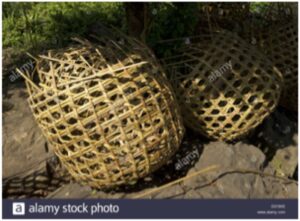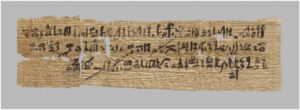Ali J.
Our modern word paper was derived from the word papyrus, and for good reason. Paper has not always been as advanced or as easy to come by as it is today. Ancient papyrus was a waxy material made from the Cyprus papyrus plant that grows along the Nile river in the freshwater marshes. While it was used by Greek, Roman, and Egyptian scholars it was strictly grown and produced in Egypt then shipped out to these places for a hefty price. While it is most popular use is for recording a written language this 10-foot-tall reed plant was also used for other things. These include, mattresses, furniture like chairs and tables, boxes, baskets, sandals, utensils, rope, and even boats, so it was very versatile. The plants stalk was not the only useful part of the plant either, as the root was used for food, perfume, and even medicine.

Papyrus baskets

Papyrus sandals
The making of papyrus was quite complicated. After harvesting the triangular plant, it is stripped to its core. The core is then sliced into very thin strips. These strips are soaked in water to remove some of the sugar content. Afterward, the water is slowly drained away as the strips are pounded flat. All these strips are then placed overlapping each other either into small sheets or long scrolls and finally pounded again. The second pounding releases a sticky substance which is the remaining sugar caused by the breaking down of the plants cellular structure that binds the sheets together. The sheet or sheets are then placed under a heavy rock to dry for six long days.
For places that were too far away to transport this luxury Egyptian good, parchment was used instead. By about 50 AD parchment had taken over the papyrus industry. Although one could not make scrolls with parchment one was able to make books out of this animal skin-based material. Ancient scholars found books to be a better way to record information because they could flip back and forth, instead of a long strip of paper where one would have to unroll and reroll many times to find the information they were looking for. After 400 AD papyrus was virtually out of the market and only being used by the Egyptians. Everyone wanted to use parchment, as it was more affordable and could be produced anywhere. After the fall of the Roman empire people were no longer interested in trading with the Egyptians, so papyrus was almost obsolete.

A fragment of an ancient papyrus
In 800 AD when the Chinese invented paper, not even the Egyptians were using papyrus anymore, because paper, like parchment, was easier to access. Finally, by 1200 AD almost every community developed their own way of making paper and it was being transported all around the world for a cheaper price then papyrus too.
The papyrus industry was demolished and almost lost to ancient civilizations and us but because of the dry climate of Egypt many remnants of papyrus documents have been left behind. From these artifacts we are able to not only get an insight into the ancient Egyptian culture, but also how the papyrus industry worked, and we can now make this material ourselves. Today the plant is still being grown in a controlled fashion by the Nile river for the production of modern papyrus. We are still able to make modern papyrus which is used today as a specialty paper by artists and calligraphers to make masterpiece pictures and even greeting cards. The Cyprus papyrus plant holds the status of a luxury once again.
Citations
Carr, Karen. “Parchment and the History of Books.” Quatr.us Study Guides, Publisher Name Quatr.us Study Guides Publisher Logo, 21 Apr. 2018, quatr.us/literature-2/parchment-history-books.htm.
Dunn, Jimmy. “Tour Egypt.” Egypt: Wadjet, Goddess of Lower Egypt, Papyrus, and Protector of Pharaoh, www.touregypt.net/featurestories/papyrus.htm.
“Egyptian Papyrus.” Egyptian Papyrus – Cyprus Plant – What Is Papyrus, 2008, www.egyptian-papyrus.co.uk/.
Szymanski, Terrence. “Papyrus Making 101: An Introduction to Papyrus.” U-M Library, 4 May 2004, www.lib.umich.edu/papyrus_making/pm_intro.html.